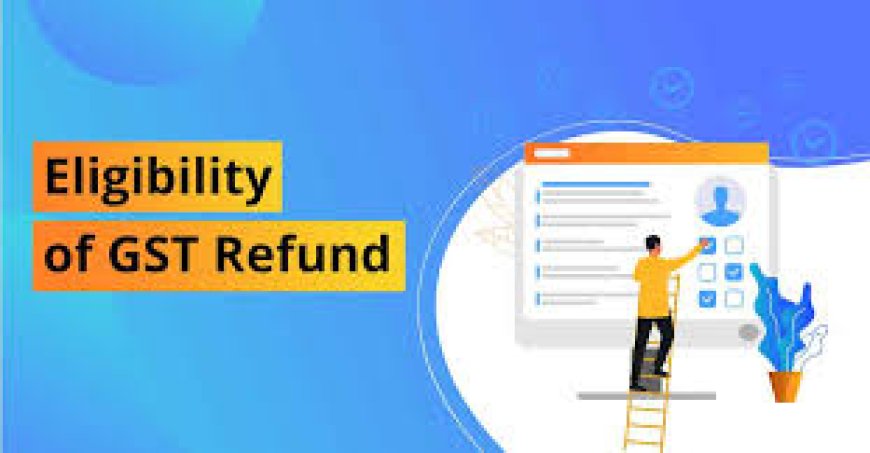What is the Eligibility Period for GST Refund?

In the evolving landscape of Indian taxation, the Goods and Services Tax (GST) has significantly simplified the indirect tax structure. Among its many components, one of the most crucial and frequently discussed aspects is the GST refund claim process. A GST refund allows taxpayers to reclaim the excess tax paid, making it a vital mechanism for maintaining healthy cash flow and promoting business ease. However, one important consideration when initiating a GST refund is understanding the eligibility period the window of time within which the refund must be claimed.
Where GST Refund Applies
GST refunds can be claimed under various scenarios, and understanding where the eligibility period applies is critical. Businesses and individuals may be eligible to claim refunds in the following situations:
- Export of goods or services without payment of tax under a Letter of Undertaking (LUT).
- Inverted duty structure, where input tax rate is higher than output tax rate.
- Excess balance in electronic cash ledger, due to advance tax payments or erroneous tax payments.
- Deemed exports, such as supplies to Export Oriented Units (EOUs).
- Refund on account of finalization of provisional assessment.
- Refund due to judgment, decree, order or direction of the Appellate Authority or court.
In all these situations, the taxpayer must be aware of the time limits prescribed under GST law to file a GST refund claim.
What is the Eligibility Period for GST Refund?
According to Section 54 of the CGST Act, 2017, a GST refund claim must be filed within two years from the relevant date. This two-year period is known as the eligibility period for filing a GST refund. If a taxpayer fails to file the claim within this time, the claim may be rejected on procedural grounds, even if otherwise eligible.
Lets understand how the relevant date is defined depending on the nature of the refund:
Relevant Dates Based on Type of Refund:
- Export of goods (without tax) Date of shipment or dispatch of goods.
- Export of services (with/without tax) Date of receipt of payment in foreign currency.
- Excess payment of tax Date of actual payment of tax.
- Finalization of provisional assessment Date on which final assessment order is issued.
- Inverted duty structure Date of filing of return for the period in which such claim arises.
- Deemed exports Date of filing of return relating to such supplies.
- Excess balance in electronic cash ledger No specific time limit, can be claimed anytime.
Advantages of Timely GST Refund Claims
Timely filing of GST refund claims comes with multiple benefits for businesses:
- Improved cash flow: Quick refunds help maintain liquidity.
- Avoidance of legal hurdles: Filing within the eligibility period prevents disputes.
- No interest cost: Delayed refund may attract interest costs, which can be avoided.
- Better compliance record: Businesses with timely refund claims are seen as compliant and reliable.
- Faster credit cycle: Enables timely reinvestment in the business.
Steps to File a GST Refund Claim
Filing a GST refund claim within the eligibility period involves the following steps:
Step 1: Log in to GST Portal
Visit www.gst.gov.in and log in using your credentials.
Step 2: Navigate to Refund Section
Go to Services > Refunds > Application for Refund.
Step 3: Select Refund Type
Choose the relevant reason for your refund claim (e.g., export, inverted duty structure, excess payment, etc.).
Step 4: File Form RFD-01
Complete Form GST RFD-01, the primary form for refund application. Upload necessary supporting documents like invoices, shipping bills, payment proof, etc.
Step 5: Verification by Officer
A GST officer will scrutinize the application. If satisfied, the refund is processed. In case of discrepancy, you may receive a deficiency memo.
Step 6: Refund Sanction
If approved, the refund is sanctioned through Form GST RFD-06. The amount is credited to your bank account.
Types of GST Refunds
Understanding the types of GST refunds helps you determine the relevant date and eligibility period more accurately:
- Refund of tax on export of goods/services.
- Refund due to inverted duty structure.
- Refund of tax on deemed exports.
- Refund due to finalization of provisional assessment.
- Refund of excess balance in the cash ledger.
- Refund due to wrong tax paid (CGST instead of IGST or vice versa).
- Refund under appeal orders or directions.
Each refund type has its own set of relevant dates that determine the start of the two-year eligibility period.
Common Challenges in Meeting Eligibility Period
- Delayed documentation: Failure to collect or organize proper documents can delay the filing.
- Unawareness of timelines: Many businesses are unaware of the "relevant date" concept.
- Lack of automated alerts: No alerts from the system means its the taxpayers responsibility to track deadlines.
- Mismatch in data: Differences in data between GSTR-1 and GSTR-3B can stall refunds.
Conclusion
The GST refund claim process is a beneficial provision for businesses, but it requires timely and accurate filing. The eligibility period of two years from the relevant date is crucial and must be strictly adhered to for a successful claim. Missing this deadline could mean losing your refund right altogether. Therefore, businesses must maintain proper documentation, be aware of relevant dates, and regularly reconcile their tax filings to ensure no opportunity is missed.
FAQs
Q1. What is the maximum time limit to file a GST refund claim?
A: The time limit is 2 years from the relevant date, as per Section 54 of the CGST Act.
Q2. Can I file a refund claim after two years?
A: No, unless allowed under special cases like court orders. The refund claim is generally rejected if filed beyond the eligibility period.
Q3. What is the relevant date for exports without tax payment?
A: For goods, it is the date of dispatch/shipping; for services, it is the date of receipt of foreign currency.
Q4. Is there a time limit for claiming a refund from the electronic cash ledger?
A: No, refund from the cash ledger can be claimed at any time as there's no eligibility period restriction.
Q5. How can I track the status of my GST refund claim?
A: Log in to the GST portal > Services > Refunds > Track Application Status.
Q6. What if my refund application is deficient?
A: You will receive a deficiency memo. You must refile the corrected application within the eligibility period.
Q7. Does the 2-year time limit apply to all refund types?
A: Most types, yes. However, refund from cash ledger is an exception.
Q8. Can the refund period be extended?
A: No, the GST law does not provide a general extension. Only judicial bodies may grant relief in exceptional cases.
Q9. What happens if I miss the eligibility period?
A: The claim may be rejected, and you may lose the opportunity to recover the excess paid tax.
Q10. Do I need a CA certificate to file a refund?
A: For claims above ?2 lakh, a certificate from a Chartered Accountant or Cost Accountant is mandatory.






































